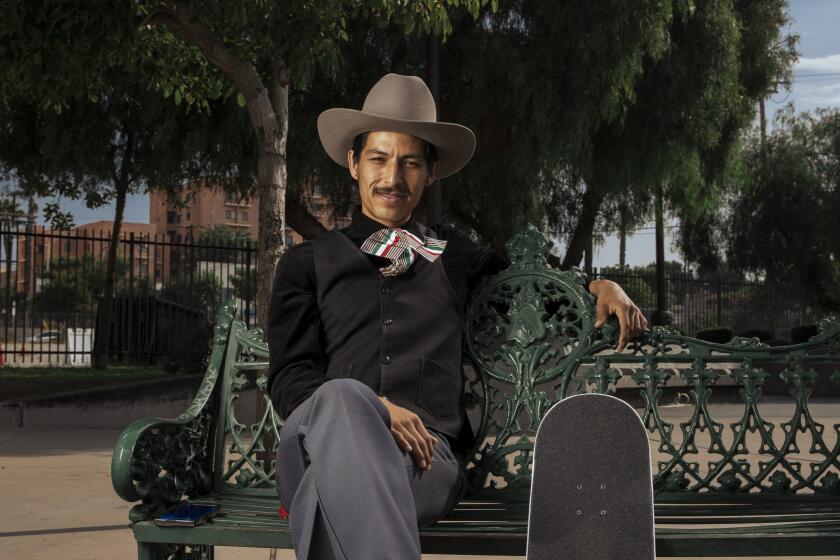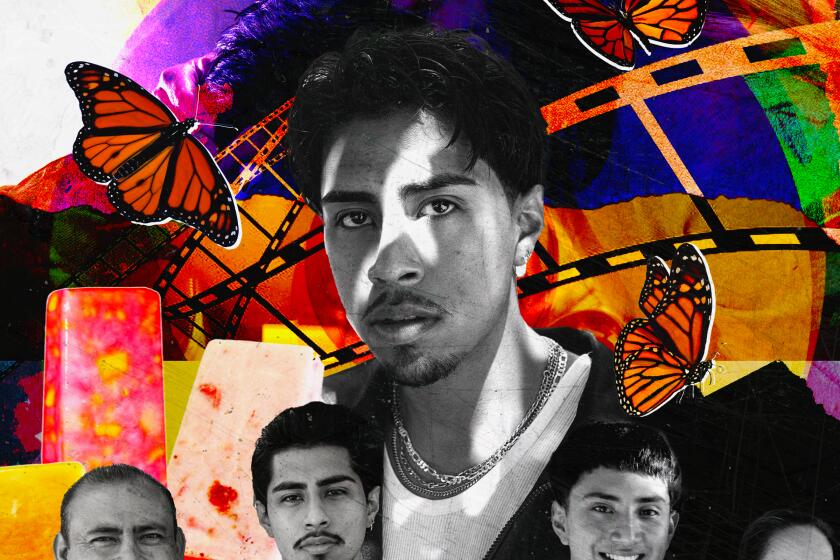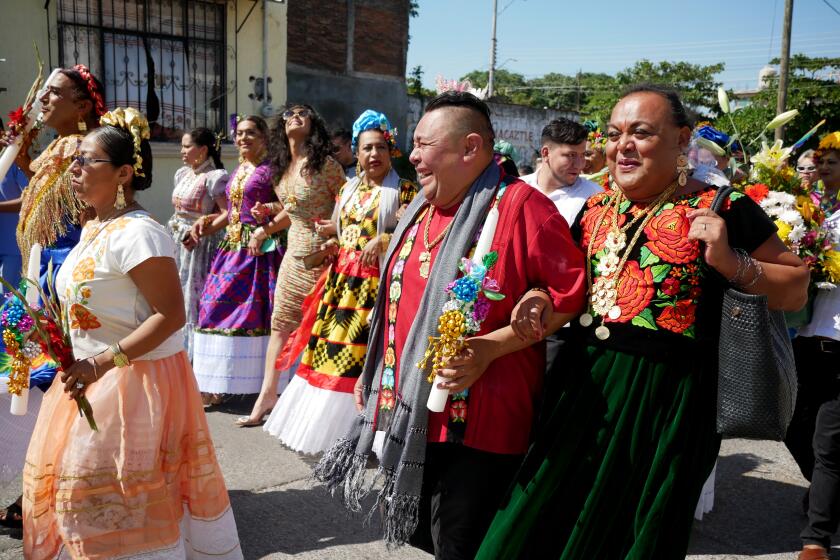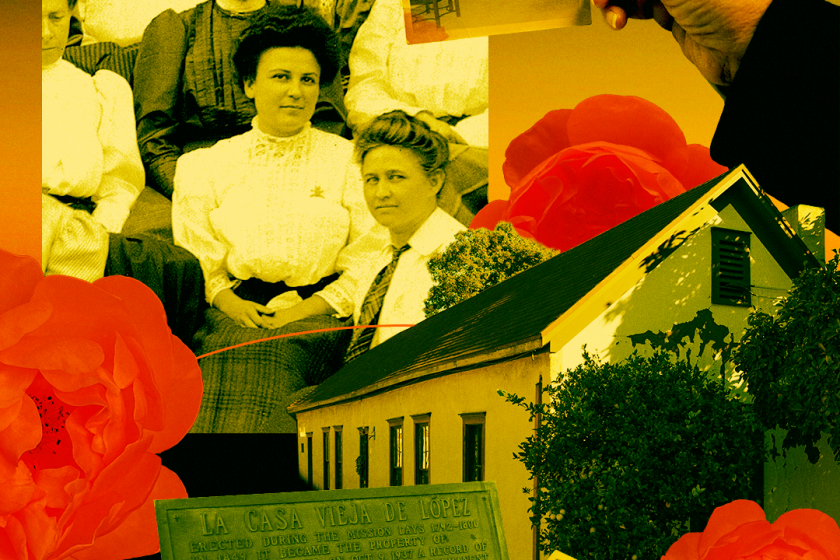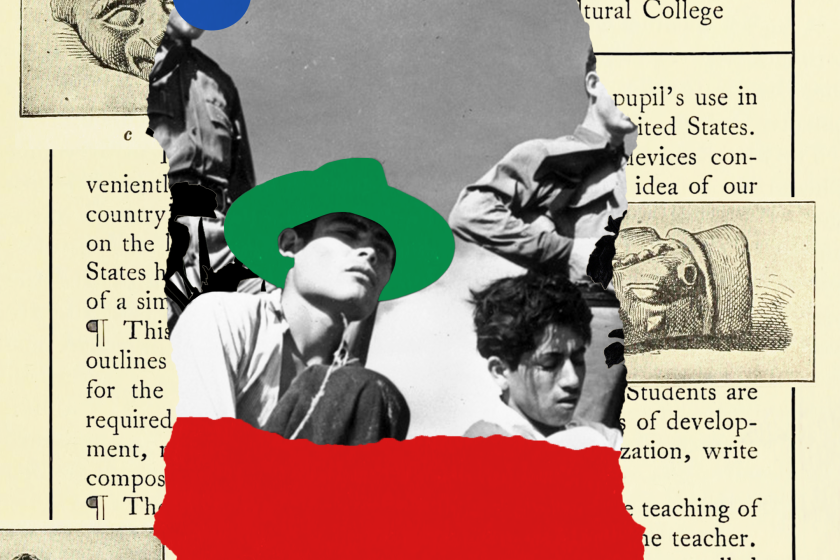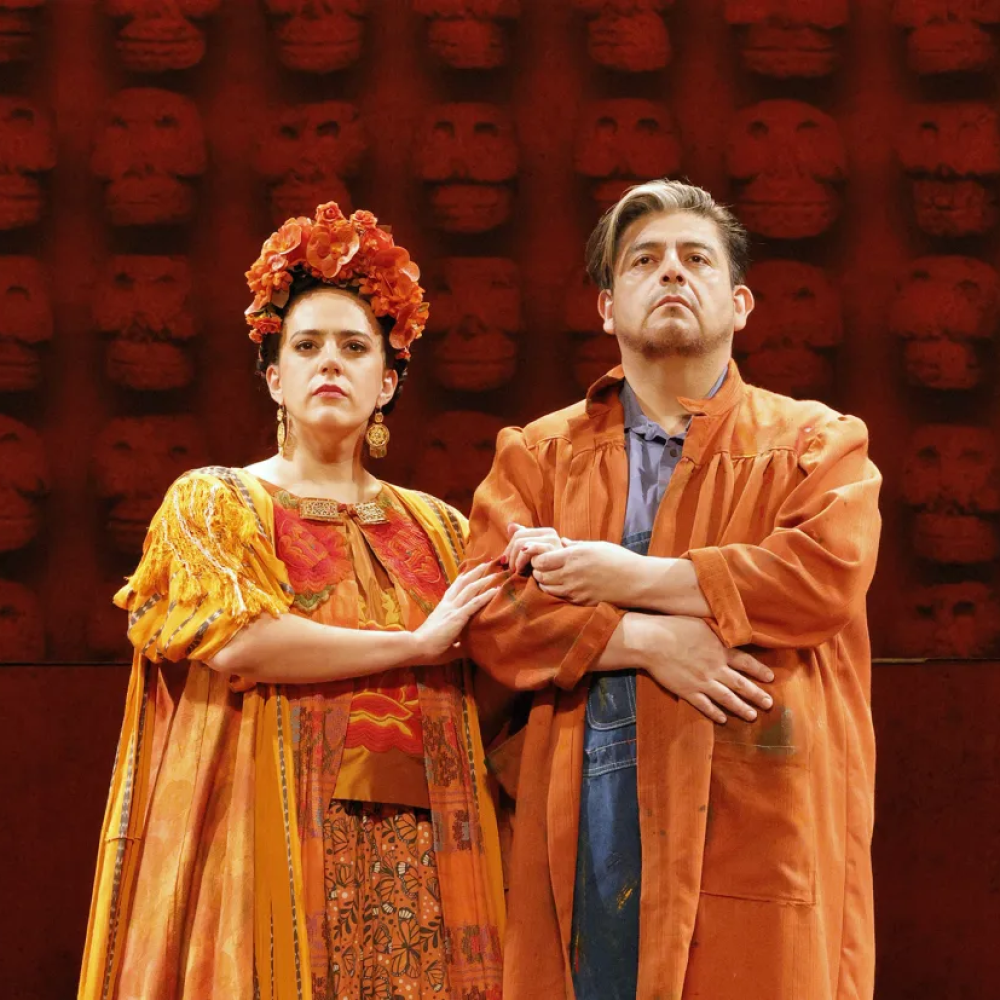
- Share via
Mexican artists Frida Kahlo and Diego Rivera meet again in the infraworld fantasy of “El último sueño de Frida y Diego” at L.A. Opera. Composed by Latin Grammy winner Gabriela Lena Frank, with the libretto by Pulitzer Prize-winning playwright Nilo Cruz, “El último sueño de Frida y Diego” reimagines the final moments between the turbulent pair across different planes.
The new Spanish-language opera runs through Dec. 9 at the Dorothy Chandler Pavilion and features closed captioning in both Spanish and English.
“It’s so important to tell the stories of Latinos on a main stage. ... There is richness and vastness in our stories,” said Lina González-Granados, L.A. Opera’s resident conductor. “Even if opera has been a Eurocentric experiment that has come to our countries, we have made it ours. Opera is ours.”
In the opera, set three years after Kahlo’s death in 1957, Rivera calls for her on Day of the Dead but she refuses to return to the world that caused her agony. A fellow departed soul inspires Kahlo to return for the sake of her art.
Steve Corona is a Los Angeles skater who has gone viral on Instagram thanks to videos that show him dressed in what he calls his ‘Pati-Charro’ aesthetic.
The opera premiered at the San Diego Opera in October 2022 and later ran at the San Francisco Opera in July as part of that company’s centennial-year lineup.
Though the storyline is new to the opera world, the concept was born more than 15 years ago.
Frank grew up encountering Kahlo’s paintings as a child, but the idea to create an opera based on the artist’s love life was initially proposed to her by the late conductor Joel Revzen. Not a writer herself, Frank joined forces with Cruz, best known for his play “Anna in the Tropics.”
The creative duo birthed an original piece moved sonically by the grandiose nature of opera.
A DACA recipient from a humble background, Ezekiel Pacheco’s story bears a striking resemblance to that of Nico, his character in ‘At the Gates.’
“Opera is grand,” Cruz said. “It’s bigger than theater because we’re talking about uniting the force of music, scenery, images, movement onstage, actors, singers, musicians.”
Together, they set out to create a new piece of art that deviated from a biographical retelling of the tumultuous love story.
The popular Mexican couple was known to have extramarital affairs. Kahlo reportedly engaged in relationships with Russian exile Leon Trotsky and some of Rivera’s past female lovers. Rivera was a womanizer who slept with Kahlo’s sister, Christina, which ultimately led to the couple’s divorce in 1939. They later reconciled and remarried the following year.
Although they continued to engage in secret love affairs, they stayed together until Kahlo’s death in 1954.
The annual celebration of Mexico’s muxes came just days after the latest high-profile death of an LGBTQ+ icon sent shockwaves through Latin America.
Cruz took inspiration from Rivera’s final request to have his ashes forever mixed with Kahlo’s at her Casa Azul in Mexico City’s Coyoacán neighborhood. Though Rivera’s request was not fulfilled at the demand of his then-wife and daughters, the conclusion of his and Frida’s love story is now reenvisioned in this opera where they exist together in the afterlife.
“I think that we as artists are strange creatures,” Cruz said. “I think Frida understood a part of him that perhaps other people didn’t and is the artist in him, and vice versa.”
As controversial as their infidelities were, Cruz believes Rivera’s final request to unite with Kahlo in death was a sign of redemption.
“You need to look at the character as if the character were a child, and to find the innocence and to find the benevolence in the character as well,” Cruz said. “Otherwise, you end up with a caricature.”
In 1937, the U.S. Department of the Interior certified that La Casa Vieja de Lopez Adobe in San Gabriel was worthy of preservation for its historic and architectural interest.
As for Kahlo, Cruz believes she would have forgiven Rivera.
“She never victimized herself. As a matter of fact, look how courageous she was in order to paint about her agony,” he said.
However, Cruz knows there are people who won’t agree with the story.
“But that’s the beauty of art, that we both have different interpretations of what a character would be like,” he Cruz.
Column: Latino history shouldn’t be a blame game or a celebration. It’s about reckoning with reality
Latino history in the U.S. is chronically under-covered in schools, according to a report from the Johns Hopkins Institute for Education Policy and UnidosUS, an advocacy organization.
The opera opens at the cemetery with village people gathered between rows of yellow and orange cempasúchil flowers and incense clouds. A light shining midstage reveals a portrait of Kahlo, who is played by Argentine mezzo-soprano Daniela Mack, with a lonesome Rivera, played by Mexican baritone Alfredo Daza, standing in front of her image. A clarinet solo assists the villagers in calling for their dead loved ones on Día de Muertos.
The first act was inspired by Kahlo’s painting “The Love Embrace of the Universe, the Earth (Mexico), Myself, Diego and Señor Xólotl,” which presents Kahlo embracing a baby Diego as they are enveloped by both a natural and a spiritual essence.
“It’s a piece of hers that inspired us to set the story during the Day of the Dead,” said Cruz.
Catrina, played by soprano Ana María Martínez, acts as the messenger between worlds and as the keeper of the dead. Catrina insists that Kahlo must return to the living world to guide a dying Rivera to the underworld.
Who are we protecting when we pretend white people don’t sometimes say wildly offensive things about people of color? It’s certainly not us.
Kahlo refuses the request, emphasizing the agony she felt in her relationship with Rivera when alive. Red rope stemming from Kahlo’s torso pulls her in every direction, likely inspired by the painter’s 1932 “Henry Ford Hospital,” where she is lying naked on a blood-stained bed with multiple umbilical cords attached to her physical and metaphysical pains.
Kahlo’s resistant return is eased when she encounters Leonardo, played by countertenor Key’mon W. Murrah, who practices a lively impersonation of Greta Garbo. Leonardo encourages Kahlo to return for herself and her art, ultimately relenting as he dresses Kahlo in her trademark floral huipil clothing.
The only condition in her 24-hour return is that she cannot touch the living.
When Kahlo returns, she finds herself in Alameda Park with Rivera, a living replica of Rivera’s mural “Dream of a Sunday Afternoon in Alameda Park,” crafted by Mexican scene designer Jorge Ballina and costume designer Eloise Kazan.
“El Tiny” completed its third annual takeover of NPR’s Tiny Desk concert series during Latinx Heritage Month. Produced by the Alt.Latino team, “El Tiny” featured eight acts from various corners of the Latino community.
“The paintings allowed me to take license and again go into this fantasy world, which was liberating for me as a writer,” said Cruz.
Though agony is at the heart of “El último sueño de Frida y Diego,” grace is a cornerstone built on Rivera’s remorse and Kahlo’s forgiveness.
Cruz hopes that the audience can walk away with a sense of spirituality, the same as he gets when he stands before the couple’s works of art.
“When I stand before those murals, when I stand before her paintings, I’m in awe, and I’m hoping that we can do the same as artists who are dealing with this great art form,” Cruz said.
More to Read
The Latinx experience chronicled
Get the Latinx Files newsletter for stories that capture the multitudes within our communities.
You may occasionally receive promotional content from the Los Angeles Times.
